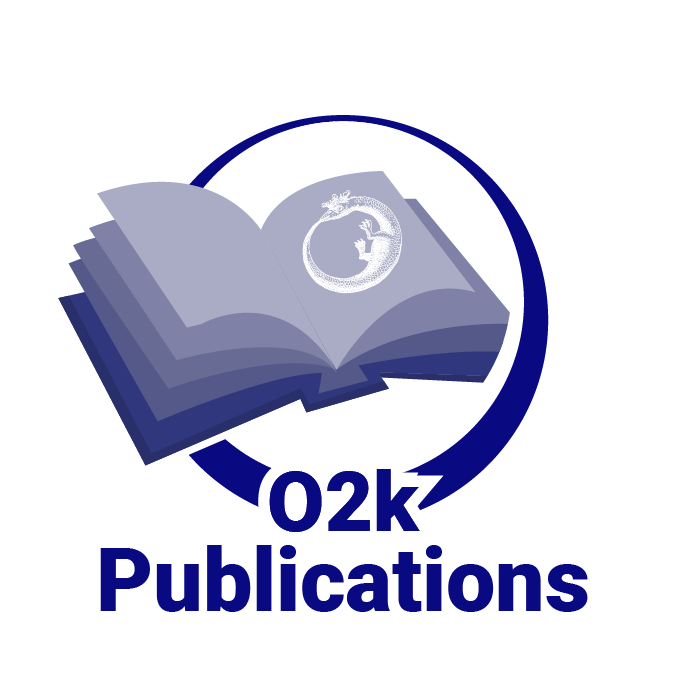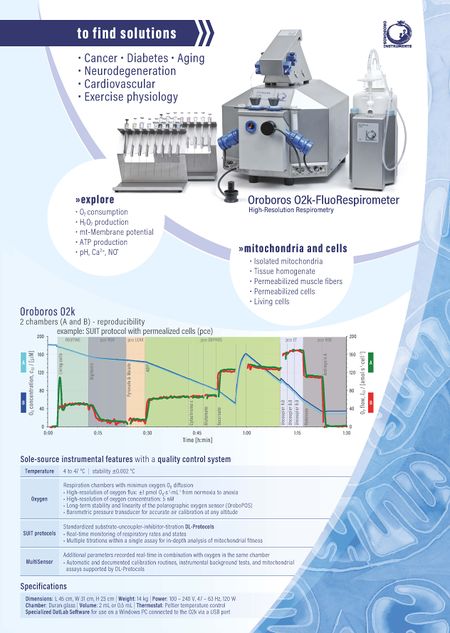MiPNet06.05 Test Experiments on O2k-Specifications
| Gnaiger E (2010) Test experiments on specifications of the Oroboros Oxygraph. Mitochondr Physiol Network 6.5. |
» ![]() »Versions
»Versions
Oroboros (2010) Mitochondr Physiol Network
Abstract: Summary: The Oroboros O2k with DatLab software is world-wide the only instrument on the market, which allows routine measurements to be made with specifications summarized under the term “high-resolution respirometry”: The limit of detection of O2 flux is as low as 0.5 pmol.s-1.mL-1. Signal noise at zero oxygen concentration is <0.05 μM O2. Oxygen backdiffusion at zero oxygen is <3 pmol.s-1.mL-1, and oxygen consumption at air saturation and standard barometric pressure (100 kPa) was 2.7 +/- 0.9 SD in 114 test runs at 37 °C. These highly standardized instrumental background fluxes are a linear function of oxygen concentration, which is used for routine background correction of oxygen flux. Typical exponential time constants of the oxygen sensors are <4 s, used for dynamic corrections in kinetic studies. Results of an extensive experimental test program are presented as the basis of Oroboros O2k-Specifications, which distinguish high-resolution respirometry from any conventional oxygraph system.
• O2k-Network Lab: AT Innsbruck Oroboros
O2k High-resolution respirometry
- The Oroboros O2k with DatLab software is world-wide the only instrument (sole source) which allows routine measurements to be made with specifications summarized under the term high-resolution respirometry (HRR).
- Continuous control of the Oroboros O2k-Specifications are a fundamental component of Quality Assurance and distinguish high-resolution respirometry from any conventional oxygraph system and from less quantitative approaches.
- » O2k-Specifications
Oroboros O2k: technical specifications
General specifications
- Dimensions - O2k-Main Unit: L 45 cm, W 31 cm, H 25 cm; 13.45 kg without packing box or Peli Case.
- Chambers: chemically inert and minimum oxygen diffusion:
- - Two Duran glass chambers with 2 mL (1.5 to 3.5 mL) volume; 16 mm inner diameter.
- - PEEK stoppers with Viton O-rings.
- - Electromagnetic stirrers with variable speed (100 to 900 rpm).
- - PVDF-coated stirrer bars (6 mm diameter).
- - Polarographic oxygen sensors sealed with butyl rubber seal tips.
- Built-in electronically regulated Peltier thermostat:
- - Temperature range:
At room temperature 4 °C to 47 °C At lower ambient temperature 2 °C
- - Temperature stability:
Temperature stability ±0.002 °C over 90 min.
- - Temperature range:
in 15 min 20 °C to 30 °C in 20 min 30 °C to 20 °C
- Data output through USB:
- - Two oxygen signals.
- - Pressure transducer, for absolute barometric pressure signal, resolution 0.1 kPa.
- - Thermostat temperature signal, resolution 0.001 °C.
- - O2k-MultiSensor:
- Series J and XB
- two additional amperometric signals (O2k-fluorescence; PhotoBiology)
- two additional potentiometric signals (Ion-selective electrodes: for TPP+, Ca2+, or pH)
- Series XB
- two additional amperometric signals for Q redox state
- two additional amperometric signals (NO)
- - O2k-MultiSensor:
- DatLab software:
- - Simultaneous display of O2 concentration and O2 flux (negative slope or time derivative), together with any selected O2k-MultiSensor channels (raw or calibrated signals and corresponding time derivatives).
- - Barometric pressure for O2 calibration; temperature stability control.
- - Automatic calibrations: O2 and O2k-MultiSensor channels.
- - DL-Protocols: real-time guide through instrumental quality control tests and advanced diagnostic substrate-uncoupler-inhibitor titration (SUIT) protocols within a single assay for exploring mitochondrial function.
- internal PC and attached screen
Specifications for high-resolution respirometry
- Oxygen signal:
- - Noise at zero O2: <±0.02 µM (SD, 100 data points recorded at 0.2 s intervals at 37 °C) without smoothing (±0.005 µM typical)
- - Noise at zero O2: <±0.002 kPa (SD, 100 data points recorded at 0.2 s intervals) without smoothing (±0.0005 kPa typical).
- - Noise at air saturation: <±0.1 µM O2 (SD, 100 data points recorded 0.2 s intervals at 37 °C) without smoothing, at 180 µM O2 (±0.05 µM typical).
- - Noise at air saturation: <±0.01 kPa (SD, 100 data points recorded 0.2 s intervals) without smoothing, at partial oxygen pressure of 20 kPa (±0.005 kPa typical).
- - O2 range of linearity: 0 to 1000 µM.
- - Time constant: <4 s at 37 °C (<3 s typical).
- Oxygen flux JO2,V [pmol.s-1.mL-1]:
- - Limit of detection: 0.5 at steady-state over 5 min.
- - Sensitivity (normoxic): <1 at steady-state over 5 min at 20-40 °C.
- - Sensitivity (hyperoxic): <3 at steady-state over 5 min at 20-40 °C.
- - Noise: <0.2 after standard smoothing (120 s).
- - O2 range: flux measured up to 500 µM O2 (permeabilized fibres), and <0.1 µM based on DatLab analysis of oxygen kinetics (mitochondria and cells).
- Instrumental background for linear correction over the entire oxygen range:
- - O2 backdiffusion [pmol.s-1.mL-1] at 0 µM: <3 at 20-40 °C (2.5 typical).
- - O2 backdiffusion [pmol.s-1.mL-1] at 0 kPa: <3 at 20-40 °C (2.5 typical).
- - O2 consumption [pmol.s-1.mL-1] at 200 µM: <4 at 37 °C (3 typical); <3 at 25 °C (2 typical).
- - O2 consumption [pmol.s-1.mL-1] at 20 kPa: <4 at 37 °C (3 typical); <3 at 25 °C (2 typical).
Labels: MiParea: Instruments;methods
HRR: Oxygraph-2k







